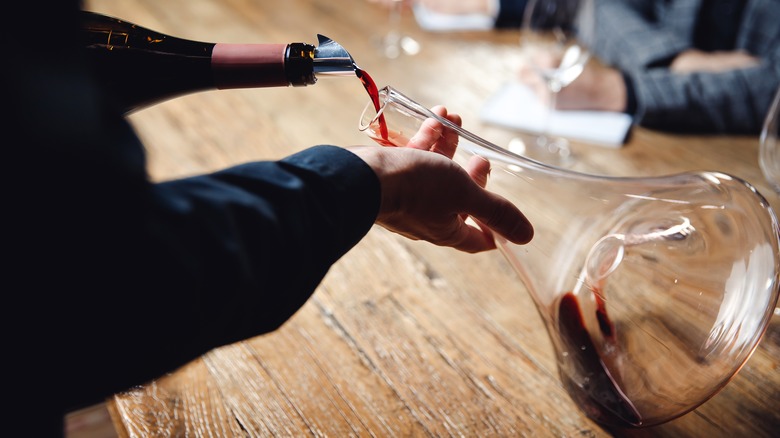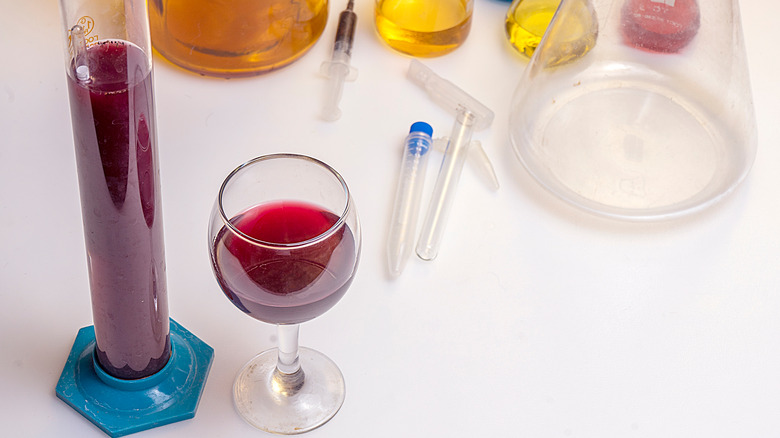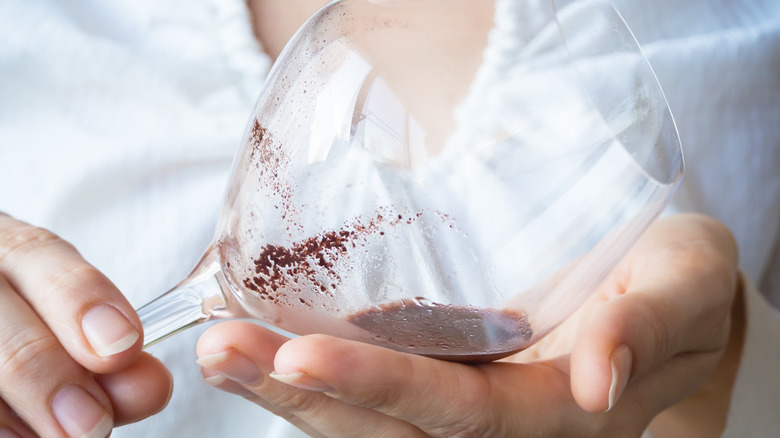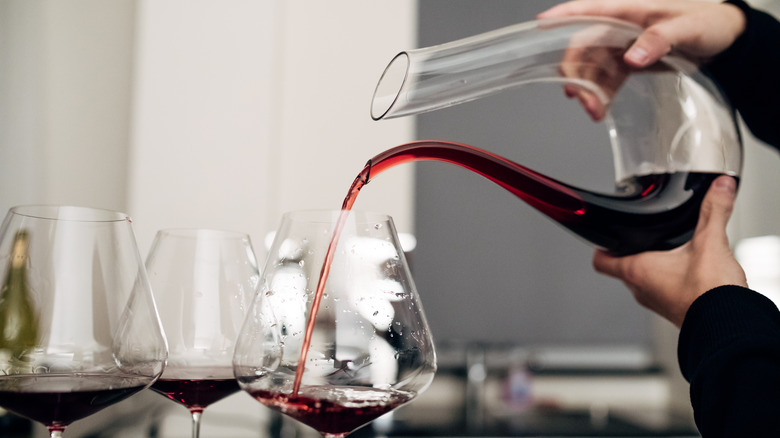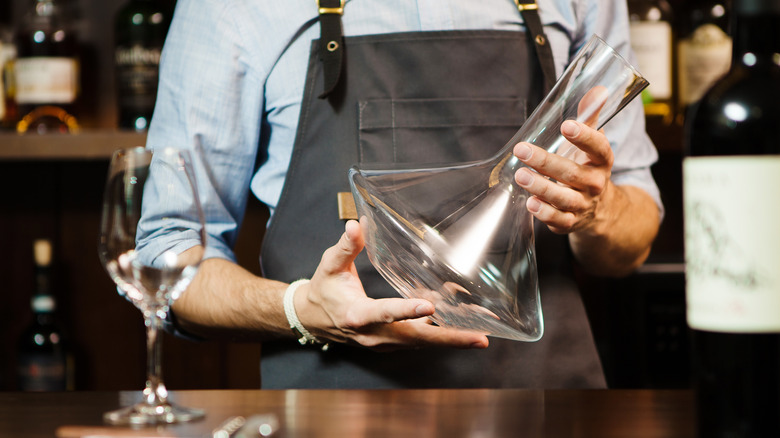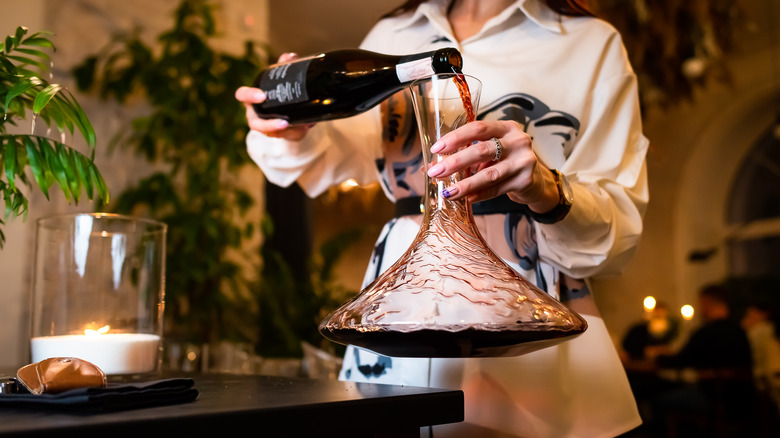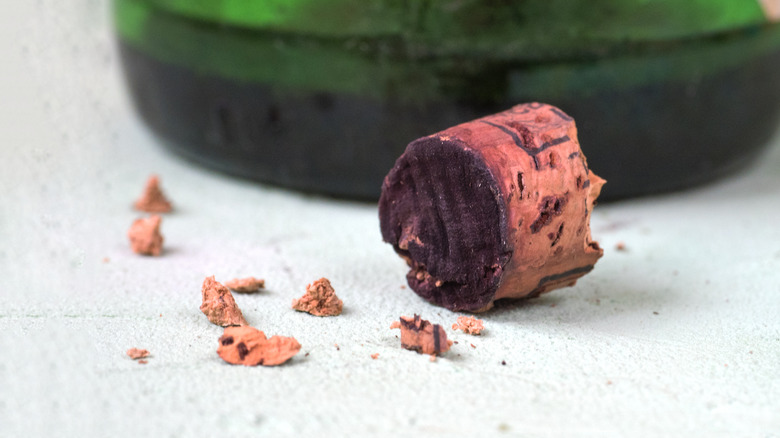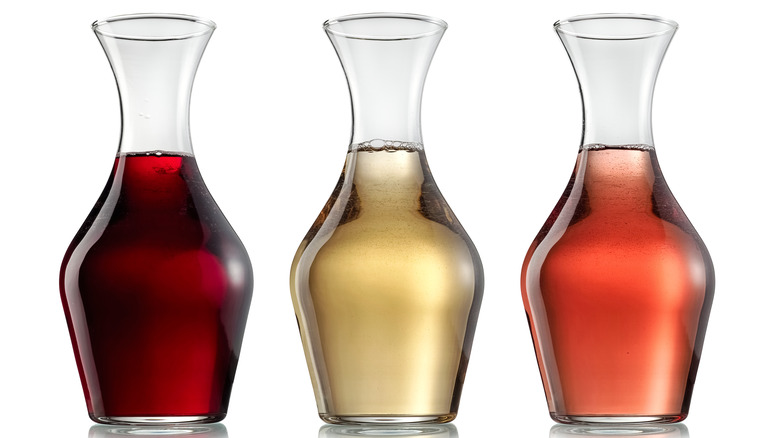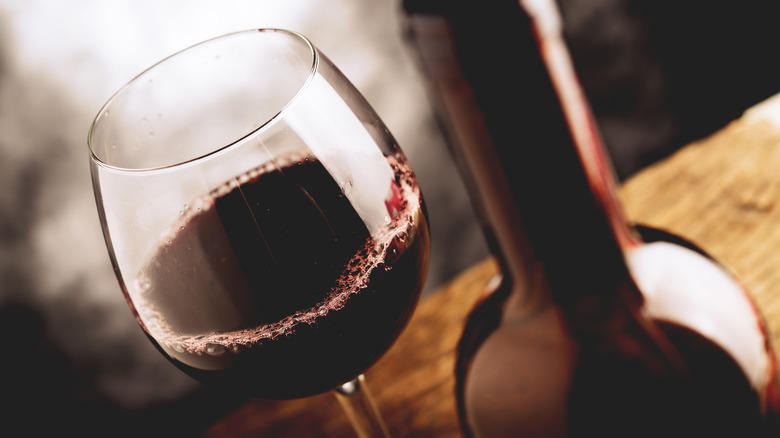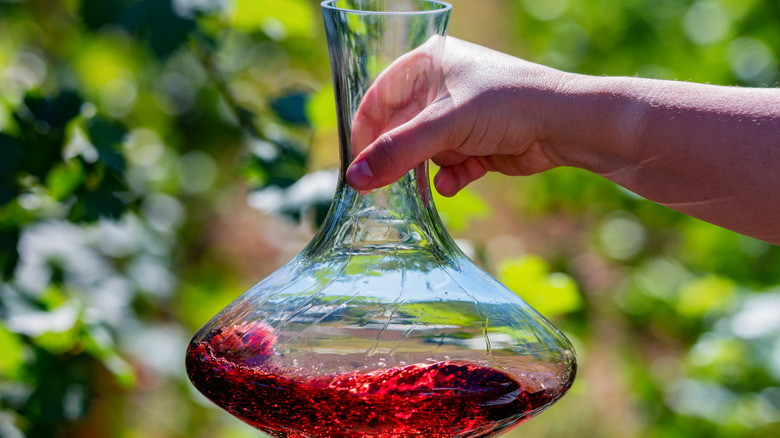The Dos And Don'ts Of Decanting Wine
You may have seen it done tableside in a posh restaurant, or at a dinner party if you have friends who consider themselves wine aficionados: a bottle of wine is carefully and ceremoniously opened and its contents are gently poured into a different glass vessel. This is the act of decanting wine. But aside from looking swanky, what does it do? Is there a point to this theater, or is it purely aesthetics?
As it turns out, there are many reasons to decant wine and many different types of wine that can benefit from the practice, as MasterClass explains. If you want to maximize your enjoyment of every bottle you uncork or unscrew, learning the basics of wine decanting is a great place to start. With a little bit of knowledge and a few tips and tricks, you'll be decanting wine like a professional in no time, impressing your friends with your sommelier skills while getting the most out of each sniff and sip of wine you drink.
Do: Understand the science behind decanting wine
To comprehend what happens to a wine when it's decanted, first the interplay between wine and oxygen must be understood. As SevenFifty Daily explains, when wine comes into contact with air, two processes occur. First is evaporation, followed by oxidation. Right away, certain compounds will dissipate as they're pulled out of the wine and into the air. Oftentimes, these are compounds that cause undesirable aromas, like vegetal or acrid smells — so getting rid of them is an immediate net positive.
Oxidation is a little more complicated, subtler, and less instantaneous of a process. Leave a wine exposed to air for a significant amount of time, and the wine will begin to transform on a chemical level, with its flavors, aromas, and textures changing as they merge with the oxygen they're in contact with. If you've ever left a bottle of wine open overnight and tasted it the next day, you've probably noticed the effects of oxidation. Too much oxidation can make a wine unpleasant to drink. But depending on the wine, some oxidation can be a good thing — extended exposure to air can deepen a wine's complexity, or soften sharp flavors or harsh textures.
Do: Know if you need to decant for sediment
One of the most practical and common uses for decanting wine has nothing to do with oxygen exposure at all, but with sediment. If you've ever gotten to the bottom of a glass and noticed a grainy substance similar in consistency to coffee grounds, you've come across wine sediment. Most often, as Wine Enthusiast explains, these particles appear in red wine that has been aged. As time passes, remnants from the winemaking process, including minuscule bits of yeast and grape parts, solidify into sediment which gravity pulls down to rest at the bottom surface of the bottle.
While this substance is harmless to ingest, it can be unpleasant, especially if it's not noticed or expected — unlike with peanut butter, nobody prefers their wine chunky style. If you're drinking a big, full-bodied red, or one with a decade or more of age on it (per Wine Spectator), assume there's going to be sediment and prepare accordingly.
The best way to avoid getting a mouthful of grit is to perform a careful decant. First, shine a light under the neck of the bottle (a candle or cell phone flashlight both work well). Next, pour slowly and carefully into the decanter, stopping as soon as you see the dark shadow of sediment appear. This way, the grit stays in the bottle and your decanter is full of nothing but delicious, smooth vino.
Do: Know what type of decant your wine needs
Before you start the decanting process, it's important to assess your wine and figure out what it needs. Each wine, depending on its style and age, is going to react differently once it's decanted, as pointed out in Scientific American. While it's impossible to predict exactly what's going to happen to each individual wine, some guidelines can give you a basic idea of the best way to decant your wine, and even whether it needs to be decanted at all.
A high-end red wine that's less than a decade old may benefit from a decant to mellow some of its more severe qualities, a process that would normally occur during a longer aging time, resulting in a smoother, softer wine. For a red wine that's aged over a decade, decanting is probably necessary to remove sediment, but delicate aromas are more likely to dissipate quickly, leaving the wine muted if left exposed to the elements for too long. As Wine Spectator suggests, 30 minutes is a good rule of thumb for older wines so you don't lose out on any fleeting flavors.
What about that inexpensive red you grabbed at the grocery store? Wine Folly recommends giving that a quick decant too, in order to let any disagreeable flavor compounds blow off. And if you find yourself with a white, pink, or light red wine that's got an acerbic bite, a decant can tone down its sharpness.
Do: Choose the right decanter style
Decanters come in all shapes, sizes, and styles, as Wine Folly illustrates. Some look like works of fine sculpture that belong in an art gallery, while others are simple, functional pouring vessels. Which one you choose to use depends largely on personal preference, but there are some practical aspects to look at as well.
The main thing to remember is that the more surface area of the wine that is exposed to air, the quicker it will develop in the decanter. If you mainly plan to use the vessel to aerate big, tannic reds like California Cabs, Bordeaux, and the like, look for one that has a broad bowl to make the process speedier. Lighter and older reds that don't need as much oxygenation will evolve at a more appropriate rate in smaller, more narrow-bowled decanters.
If you're worried about breakage, opt for crystal or borosilicate over standard glass. While your aesthetic eye might be drawn to some of the more ornate styles of decanters, take into consideration how easy or challenging they might be to clean and store, or even just to pour from, especially if they're crafted in an awkward shape. If a decanter is too much of an annoyance in these practical ways, you might be left with a beautiful but quite expensive paperweight.
Do: Make sure the decanter is clean and dry
Decanters' shapes can make them difficult to efficiently clean and dry, and you want your decanter to be both before you fill them with new wine. To add to the challenge, most experts recommend not using soap to clean them, as it can cause residue buildup that may alter the wine's taste. Dishwashers are out of the question for all but the sturdiest decanters as most can easily chip and break (per Wine Enthusiast).
Thankfully, there are plenty of solutions to ensure a spotless decanter. As soon as possible after pouring out that last drop of vino, get some hot water in the decanter to rinse away the initial stains before they have time to settle for good. Then, for a more thorough clean, there are specialty tools on the market such as cleaning beads or long, flexible cleaning brushes designed especially for decanters' unusual shapes (per BinWise). But there's no need necessarily to invest in specialty tools — simple combos of hot water and vinegar, water and baking soda, or salt and ice can also do the trick sans soap.
Drying is another challenge and one you'll want to tackle right away to avoid spots and buildup, as Advanced Mixology explains. Hanging a decanter on a drying stand is the simplest method, but takes time. For a quicker dry, use a specialty drying brush, or roll a cylinder out of cheesecloth or lint-free paper towels to reach the inside surfaces.
Do: Follow proper decanting steps
When it gets down to basics, the actual process of decanting wine is quite simple: open a bottle and pour. However, there are certain nuances to keep in mind and steps to follow to ensure the procedure goes as smoothly as possible, and you can fully enjoy your decanted wine without a hitch.
If the wine is likely to have sediment, ideally you want to make sure it stands vertically for at least a day to let the particles settle before you attempt to decant them away, as Wine Spectator suggests. When it's time to do the deed, open the bottle and get your clean, dry decanter ready. For a sediment-heavy wine, a slower pour is best — it'll give you a better chance to catch the sediment as it comes to the neck and stop the pour before any grit escapes into the decanter. Riedel recommends also giving older wines a slower pour, and a gentle one, as too much aeration could cause any delicate flavors to degrade quickly. Treat young wines a bit more roughly, as swirling and splashing can jumpstart the evaporation and oxidation processes that'll help the wine soften and develop.
Once the wine has settled in its decanter, the clock starts ticking. According to Wine Folly, a wine's sweet spot can show up anywhere from 20 minutes to over two hours, depending on color and style. Don't be afraid to taste it periodically to follow its development.
Don't: Panic if the cork breaks
It's one of the wine drinker's most harrowing moments: in the middle of opening a bottle of wine, something feels off, and wouldn't you know it, that pesky cork has fallen apart. As described in Wine Spectator, no matter if it's due to improper storage, disintegration from old age, or an overly aggressive corkscrew, the problem remains the same: a crumbly, broken cork is going to leave unappealing debris floating in the wine.
Even if the wine in question was not initially destined for a decant, it's a great course of action to take to ensure a smooth, cork-free drinking experience. In this situation, unlike a typical decant, an extra step is required to keep any bits of cork from smuggling their way into your decanter: filtration. Vinepair recommends using cheesecloth or an unbleached coffee filter, either attached to the bottle itself or over the opening of the vessel you're pouring into (you can do this directly into a glass, as well, if you don't want to decant an entire bottle). Any fine strainer or sieve will do. The barrier will allow the wine to pass through while keeping any unwanted solids out. Even if you don't plan on decanting wine regularly, a decanter is a nice thing to keep around for just such an unfortunate occasion.
Don't: Get rid of the original bottle
You may find yourself in a situation where you would like to decant a wine well in advance of, say, a dinner reservation or a gathering with friends. Bringing a fragile decanter or one without a stopper along for the ride is probably not the best idea as they're certainly not made for travel. One bump in the road could spell doom for your precious wine and its fragile container.
That's one reason why, as MasterClass points out, it's always a good idea to keep the wine's original bottle and cork or cap (or another wine stopper, if your cork is broken or crumbling) after decanting. If the bottle contains leftover sediment, give it a rinse and let it dry while the wine sits in its decanter. Once it's ready to go, you can funnel the wine back into the now clean bottle and you're ready to close it up and safely take it with you. This practice, known as double decanting, isn't just practical for traveling purposes. According to Decanter, a double decant will greatly benefit big, tannic reds, especially young ones that need extra contact with oxygen to fully develop.
Don't: Store wine in a decanter for too long
The question of how long to decant an individual wine is a tough one, so following basic guidelines from experts like Wine Folly is helpful. As noted previously, most wines will benefit from a decant between 20 minutes to two hours depending on color, style, and age. But there is such a thing as over-decanting: when the benefits of airing out the wine have reached their peak and the wine's quality begins to fade.
Certain wines are more at risk for over-decanting than others. A mature wine's aromas and flavors can be fleeting once they meet oxygen, so it's best to err on the side of caution when it comes to wines that have been around for a decade or more, as Wine Spectator points out. Younger red wines are more durable and can last in a decanter for hours before their flavors start to degrade. If you're unsure if you'll finish the wine before it starts to fade, you can always funnel it back into the original bottle and cork it to give it a longer life.
Don't: Only decant red wines
Red wines get all the love when it comes to careful and thoughtful decanting, but what about the rest? Turns out, decanting can benefit all kinds of wines, not just reds, according to Wine Enthusiast. Since decanting helps get rid of unwanted flavors and aromas and intensifies the pleasant ones, it's just as useful for whites, rosés, and even some sparkling wines as it is for reds.
If you open a bottle of white or rosé and it seems muted, a quick spin into a decanter can help the wine become more expressive as it aerates. Temperature is another factor to consider. If your wine is too cold, it'll warm up faster in a decanter, as it has more exposure to room temperature. While most whites and rosés don't have the same sediment issues as reds, they can have "wine diamonds," which are small solid bits of tartrate that resemble salt or sugar crystals. These harmless granules are a natural product of temperature fluctuation, as VinePair explains. However, just like with sediment in red wines, it can be unpleasant to get an unexpected mouthful of solids as you're sipping, so a careful decant is a great way to leave them behind.
Decanting sparkling wines is more complicated, as exposure to air means the bubbles will fade quickly. VinePair, therefore, suggests limiting your sparkling decants to well-aged Champagnes that have naturally already lost some of their fizz.
Don't: Assume you should decant every wine
While many wines will benefit from being decanted, there are a few styles that don't need to be and in fact, may be less enjoyable after a decant. As mentioned in Wine Spectator, wines older than a decade may be in danger of losing their aromas and flavors quickly once exposed to oxygen, so decanting these wines is always going to be a perilous proposition. It's always okay to forego a decant if you don't think it's worth the risk. Wine Enthusiast recommends tasting the wine first after opening the bottle — you might find it's great right out of the gate and doesn't need improvement.
Certain styles of white wine are also unsuited for the decanting process. While many of the aromas that blow off wine during decanting are unpleasant, some wines can lose aromas and flavors that you want them to keep. As Wine Folly explains, a wine like Sauvignon Blanc contains certain aromatic compounds that give it its character. These tropical and citrus aromas can disappear quickly when exposed to air. It's best to enjoy these types of wines straight from the bottle and into your glass to preserve the freshness and intensity of these aromas and flavors.
Don't: Overthink it
The world of wine can be overwhelming with all of its guidelines and rules of etiquette, and it's worth taking a step back sometimes and remembering that wine is meant to be enjoyed. Certainly, learning the proper way to decant can enhance your enjoyment of wine. But if worrying about it causes stress, is it enhancing or actually ruining the drinking experience?
Keep in mind that wine tasting is largely, if not completely, subjective, as noted by an opinion piece in Wine Spectator. Our senses and minds can be easily fooled, as a study in Science Daily shows, manipulating the price of a wine can change the drinker's perception of its quality. Perhaps the same could be said for decanting.
If one believes a decanted wine tastes better and understands and appreciates the process, then decanting wine can be part of the enjoyment of drinking it. Not everyone is going to like the changes every wine goes through, as Smithsonian Magazine points out. So if the effort doesn't seem worth it, it's fine to forget it. Whatever vessel you prefer to pour from, drinking wine should never be a chore; it should always be a pleasure.
